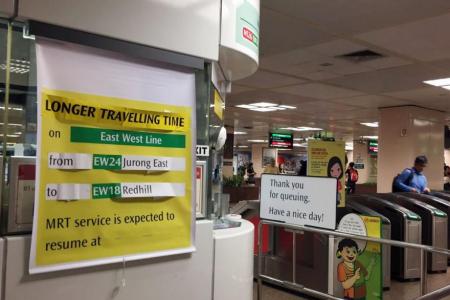Train delays: To tell or not to tell
Rail operators are required to inform passengers of a delay only if it exceeds 10 minutes, and some commuters are displeased
I have been told that I am a lucky commuter, because I have been caught in only one train delay in recent years.
It happened on the morning of Sept 19 - I was in a long but orderly queue to get on the train at Eunos MRT station when I heard an announcement over the speakers to expect a 10-minute delay because of a track fault between Pasir Ris and Tanah Merah stations.
I guess I was also "lucky" to have been caught in a delay that was not too serious - it did not warrant any notifications on rail operator SMRT's social media pages or the Land Transport Authority's (LTA) My Transport app. But many tech-savvy commuters affected felt that SMRT's online silence was deafening.
In response to queries, an LTA spokesman told The New Paper on Tuesday that rail operators are required to inform passengers of a delay only if it exceeds 10 minutes.
"Besides regular announcements within stations and on board trains, updated information is also disseminated through other channels, such as mainstream media and social media, for greater outreach if the delay worsens," she added.
A recent study by Singapore Management University (SMU), which found a sharp fall in commuters' satisfaction with train services this year, noted that sufficiency of train arrival information and accuracy of information had a positive impact on the quality of service.
Mr Chen Yongchang, head of research and consulting at the Institute of Service Excellence at SMU, said: "When these expectations are not sufficiently met or are unavailable, dissatisfaction may arise and, in certain circumstances, lead to negative word of mouth."
It did not help that most commuters that day probably experienced a delay longer than the 10-minute extra travelling time promised.
Rail experts said the extra travelling time announced will probably apply only to passengers on the "first train" that resumes normal service, but there is usually a chain effect on subsequent trains and stations.
Singapore Institute of Technology assistant professor Zhou Yi listed the factors that make it difficult to estimate the duration of a delay:
l To rectify a fault, trains may be stopped, and restarting the train takes time.
l When service resumes, the interval between trains might also be longer than usual as the operator may implement temporary speed restrictions for safety.
l In the meantime, the number of passengers entering the stations will increase, and trains will have to stay longer at each station to allow everyone to board.
National University of Singapore transport researcher Lee Der-Horng thinks that the rail operators should "exaggerate" the extra travelling time. They can also indicate a range of the duration of the delay, which will be different depending on the station, he added.
He said: "It is important that commuters know how to interpret the extra travelling time and make plans accordingly."
Prof Zhou thinks that the operators should also realise the importance of human interaction during a train delay, such as well-trained staff at the stations to provide information.
An intelligent transport system could also be developed to suggest alternative routes.
PRecious Communications managing director Lars Voedisch, who specialises in social media and crisis management, conceded that the operators are "between a rock and hard place" when it comes to announcing travel delays.
Like the transport experts, he pointed out that broadcasting shorter travel delays online might not necessarily change the travel plans of the many people who rely heavily on the trains.
But he added that transparency is the best policy, saying: "The operator will get scathing comments regardless of whether they announce the delay, but a 10-minute delay could still be significant for some passengers."
Get The New Paper on your phone with the free TNP app. Download from the Apple App Store or Google Play Store now



